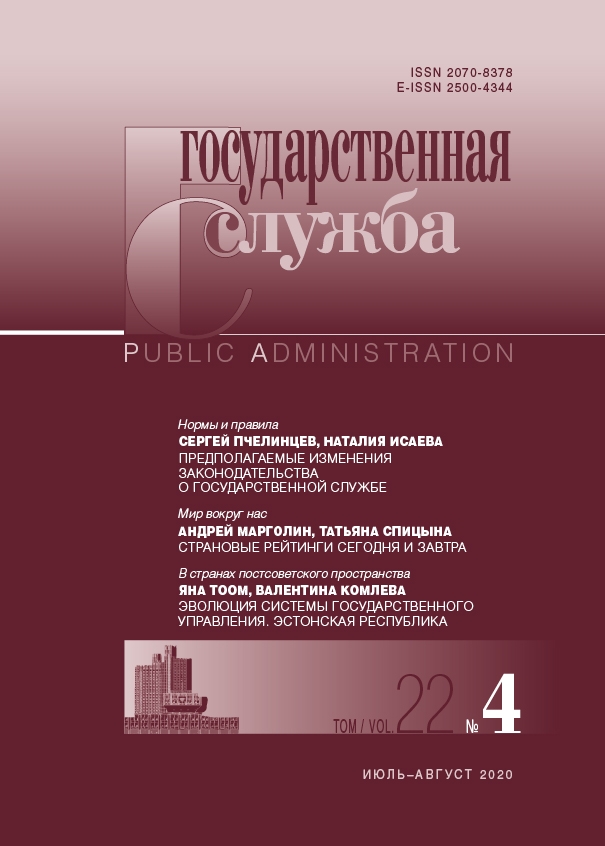Recommended link to article:
ANDREY M. MARGOLINа
TATIANA A. SPITSYNAа
аRussian Presidential Academy of National Economy and Public Administration
DOI: 10.22394/2070-8378-2020-22-4-42-55
Abstract:
Practical use of the most well-known country ratings does not always allow obtaining objective information about the real situation in various countries and assessing the prospects for their development. Popular wisdom expressed by the aphorism ‘We have not noticed how the truth has been replaced with ratings’ is becoming increasingly popular. The article proposes a tool for analyzing the relationship between the positions of different countries in the most popular ratings, based on the use of a matrix of paired correlation coefficients, assessing their significance according to the Pearson criterion and the strength of the correlation connection on the Cheddock scale. Based on the calculations, it was found that the dynamics of the countries advancement in the Doing Business ranking did not have statistically significant correlation with almost any ratings and macroeconomic indicators characterizing the real dynamics of socio-economic development. Shortcomings in the methods of ranking countries by prosperity, social development, rule of law index, level of perception of corruption, global happiness index are considered. Arguments are made that once the Coronavirus pandemic has been overcome, it is more likely that ratings will be more in demand to assess the quality of national security and the extent to which sustainable development goals have been achieved. It is proved that it is advisable to include the Global competitiveness rating, Human development index and SDG index as the most promising ratings that clearly demonstrate the country’s specific achievements in economic reforms and the growth of its international prestige.
Keywords:
country ratings, statistically relevant correlation, national security, sustainable development
Received:
June 22, 2020
References:
Analysis of Russia’s implementation of international standards according to the recommendations of Group of States Against Corruption, GRECO. Round 4. / Ed. by Shumanov I. V. М.: Transparency International Russia. 2019. 145 p. In Russian
Barabashev A. G., Makarov A. A., Makarov I. A. On the improvement of indicative quality assessment of public administration. Voprosi gosudarstvennogo upravleniya. 2019. № 2. P. 7–38. In Russian
Bucher S. The Global Competitiveness Index as an Indicator of Sustainable Development. Herald of the Russian Academy of Sciences. 2018. Vol. 88: 1, P. 44–57. In English
Doshi R, Kelley J, Simmons B. A. The Power of Ranking: The Ease of Doing Business Indicator and Global Regulatory Behavior. Cambridge University Press (CUP) in International Organization. 2019. Vol. 73. P. 611-643. In English
Idrisov G. I., Mau V. A., Bozhechkova A. V. Searching for a New Growth Model. Voprosy Ekonomiki. 2017. № 12. P. 5 – 23. In Russian
Human Development Report 2010. The Real Wealth of Nations: Pathways to Human Development. New York: Palgrave Macmillan, 2010. 244 р. In English
Mau V. A. National goals and model of economic growth: New in the Russian socio-economic policy of 2018-2019. Voprosy Ekonomiki. 2019. № 3. P. 5-28. In Russian
McCormack G. Why ‘Doing Business’ with the World Bank May Be Bad for You. European Business Organization Law Review. 2018. № 19. P. 649-676. In English
Senchagov V., Ivanov E. Structure of the mechanism for modern monitoring of Russia’s economic security. M.: Institut ekonomiki RAN, Centr finansovyh issledovanij. 2015. 46 p. In Russian
Sustainable Development Report 2019. New York: Bertelsmann Stiftung and Sustainable Development Solutions Network (SDSN). 2019. 478 p. in English
The Global Competitiveness Report, 2019. Editor by Klaus Schwab. World Economic Forum, 2020. 666 p. In English
Zarghami E., Fatourehchi D. Comparative analysis of rating systems in developing and developed countries: A systematic review and a future agenda towards a region-based sustainability assessment. Journal of Cleaner Production. V. 254. In English
Articles in Open Access mode are published under the Creative Commons Attribution 4.0 International (CC BY) license.

